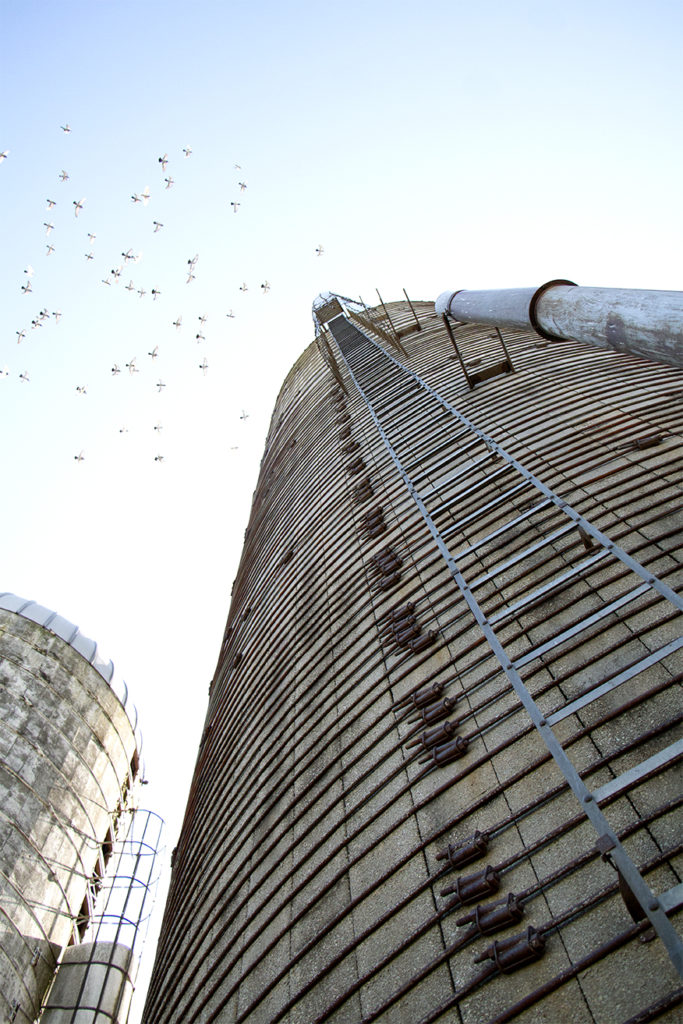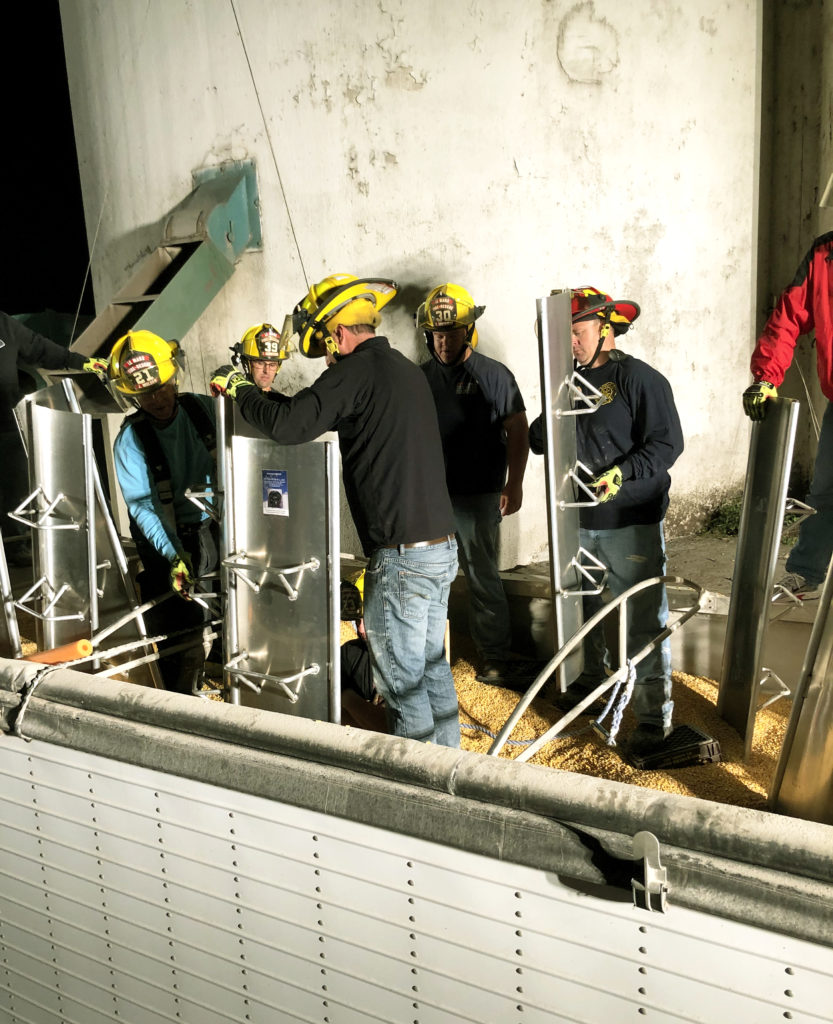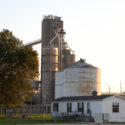Poorly maintained corn silos and bins facilitate excruciating, exhausting battles for survival.
The only time Joshua Stuber flew in a helicopter, he wasn’t able to look out the window and enjoy the aerial view. Then again, if he had, the only thing he would’ve seen was the steel-skinned, bean-bellied beast that had eaten his entire left leg: a grain bin.

Mainly, he focused on staying alive.
“The biggest thing is, I just couldn’t breathe with the loss of blood,” Stuber says. “I just had to struggle with every breath.”
Grain storage facilities are dangerous—there’s no doubt about it. The sheer amount of grain they hold, coupled with the formidable machinery needed to transport it, makes for a risky work environment. For Stuber, the adversary was an auger—a large, mightily horse-powered drill used to usher and funnel grain—embedded in the floor of a flat shed. In early June 2018, Stuber slipped on the soybeans that studded the floor like marbles and fell into the machine as it was running. Within seconds, the auger ripped off his leg from the hip.
“You can’t get too comfortable with stuff you do every day,” Stuber says. “An easy little mistake can cost you a lot.”
Most tragedies involving grain bins as villains, though, tell a very different story. It’s the nightmare for a lot of farmers: asphyxiating in tens of thousands of bushels of corn. Being literally engulfed by grain. Bill Field, professor of agriculture at Purdue University and one of the nation’s experts in confined space-related injuries and fatalities, says around 70 percent of these accounts end in death.
Capitalism

Errors leading to grain bin entrapment are often committed the year prior. A wet harvest season yields damp grain, which, when left unattended in humid conditions for months, will mold and spoil. This causes the grain to harden unevenly across the bin, clustering in some areas, leaving pockets of air in others, and caking at the surface and against the walls. In order to salvage all available corn, and thus their income, workers enter the bin to break up these chunks.
“It becomes hard, so you’re walking on a shelf, and you don’t realize it,” says David Schipper, fire rescue chief of Le Mars Volunteer Fire Department in Iowa. “Underneath you might be a void space or a gap, or there is no grain, and all of a sudden, that shelf cracks or breaks loose, and down you go. Or you’re walking on grain, and it shifts for some reason. It acts like quicksand, at times. It sucks you in. The grain cascades out of control.”
Once immersed in the grain, mobility is severely limited. Every movement further restricts any available breathing space until the chest concaves under the pressure of the corn. The force of the grain on the body combined with the gravity pulling down means that the amount of force required to pull the victim out of the grain is enough to sever the spinal cord.
If farmers keep their corn at appropriate humidity levels—around 14 percent humidity upon entering the bin—and shelter it from the elements throughout the year, there are few, if any, reasons why anyone should have to enter the bin at all. But as big agriculture inflated in the Midwest, so, too, did the size of corn storage facilities; the largest grain bin offered commercially holds just under 1,300 semi-truckloads of grain. And since less and less corn is used directly for human consumption, attention to corn quality has diminished.
“The problem is, we haven’t designed these structures for bad-condition grain,” Purdue’s Field says. “The design has not kept up with the size or the strategies and methods to remove grain from such large structures.”
Recovery mission, not a rescue

Fire Chief Schipper has assisted in seven to ten grain bin entrapments over the course of his 30 years of rescue service. Of those incidents, only two victims survived.
“You do this job to save somebody,” Schipper says. “There’s no doubt about it. That’s what we do; we save lives and we save property. But a lot of these are recoveries. They’re not rescues.”
Iowa is the nation’s leader in corn production. Proportionally, the state also harbors the plurality of nationwide grain bin entrapments every year. So, when the call comes in, usually around harvest or in the spring, Schipper assembles 10 to 20 volunteer firefighters and amasses the equipment they’ll need: grain bin panels, rescue tubes, carbon dioxide and oxygen monitors, air packs, masks, ropes and harnesses, padlocks, hand-held auger systems, buckets, sticks, and, if need be, an aerial ladder truck. Then, they head out.
“You live in the Midwest in some of these smaller communities, where everybody knows everybody,” Schipper says. “So, you go to a farm where, a lot of the time, some of your rescuers or firefighters know the people that live there, know whose farm it is. And you get in there and see that person maybe already deceased, or they’re in there and completely buried, and you’ve got to find them. It’s tough on everybody; it really is.”
When they get to the bin or silo, the firefighters make a point to shut off and lock all mechanical systems in and near the bin; as Stuber knows well, a running auger is dangerous, especially in the midst of a rescue operation. They’ll monitor the carbon dioxide levels in the facility and, if need be, ventilate the bin by splicing holes into its side.
When entering the bin, it’s important the firefighters are securely belayed with ropes and harnesses. If the victim is completely submerged, the rescue team will poke into the grain using sticks until they find him or her.
Then, the hard labor begins. The volunteers shove into the corn a rescue tube—a metal or plastic cylinder designed, but unpatented, by Purdue University to cease the cascade of corn in immediate proximity of the victim. The tube swaddles the victim, alleviating some of the crushing pressure.
“We get those tubes around them to keep the rest of the corn from falling on them so we can scoop that out,” Schipper says. “We create that hollow tube that we can pull them out of.”
All that’s left to do is dig. But around this time, another foe emerges: the temperature.
“We’ve worked in bins before where the temperature not in the corn but in the bin was over 120 degrees,” Schipper says. “Down in the corn, you can probably double that, or triple that. If you put a human body in an oven at 600 degrees, you’re going to cook it.”
Hard labor at such high temperatures mandates shorter shifts with frequent rotations; that’s why so many firefighters show up to the scene. Depending on the depth of the victim, the rescuers spend anywhere from one to six hours digging, taking a break, digging, taking a break…
By the time the firefighters unearth the victim, the likelihood of survival is low. If alive, the victim’s breath is heavy. Their skin is dimpled and bruised, their blood pressure having fought the compression for so long.
“We go and we hope we can save somebody, but the odds are against us,” Schipper says. “We’re human. It’s tough on the fire department. It’s tough, of course, on the family. It’s tough on everybody that gets involved. You wish that they just wouldn’t get in the bins, and you tell farmers, ‘Don’t get in them. Don’t get in them. Don’t get in them.’ But inevitably, we’ll have the most [of these deaths] in the Midwest in the state of Iowa.”
A Rare Scare
There are a thousand ways to die on a farm. With that much heavy machinery and equipment, livestock, and chemicals, farms are innately dangerous. So much so that, according to USA Today, farming ranks as one of the Top 10 Most Dangerous Jobs in America. But grain bin entrapments: they constitute only a tiny component of that equation. Tractor rollovers pose a far higher risk to farmers, having claimed several thousand lives over the years. By contrast, with just under 1,300 documented cases in history, grain bin entrapments are relatively rare, Purdue’s Field says. The most cases recorded in a single year is 51, and that was nine years ago.
Nevertheless, Field says he gets a call at least once a week from media outlets eager to highlight grain bin entrapments. Rarely do they ask about tractor rollovers. Field’s theory: humans are exceptionally more afraid of death by suffocation than other forms of death.
Ryerson University anxiety research psychologist Kirstyn Krause thinks otherwise. She says a recent U.S. study indicates that only 4.5 to 12 percent of Americans have a specific phobia of claustrophobia, the only anxiety disorder that explicitly identifies a fear of suffocation.
“If someone were to fall into a grain bin and they weren’t able to breathe, being really afraid in that moment and being afraid of suffocating is a perfectly adaptive, normal response to that situation because that person is in literal danger,” Krause says. “In that particular situation, you would assume the entire population would have a very high level of fear and anxiety and a very high fear of suffocating and of death because they are actually in a situation where that likelihood is matching the level of anxiety that they have.”
The same, Krause says, goes for tractor rollovers. So while the media typically emphasize the devastation of death by corn silo, thereby thwarting the one-to-one correspondence between coverage of an event and the likelihood of that event occurring, humans are not explicitly more afraid of suffocation than other forms of death. Rather, it’s likely grain bin entrapments are newsworthy events because they are so rare.
By contrast, tractor rollovers are too similar to car accidents to garner much attention. Whatever the case, it’s agreed that corn silos shouldn’t double as coffins. Nationwide Insurance hosts a Grain Bin Safety Week in February to further raise awareness of the topic.
“These cases are so hard to defend anymore because the problem is so well known,” Field says. “No farmer in the United States who raises grain can look a jury in the face and say, ‘I didn’t know about this.’”
Towering Obstacles
Stuber’s own grain bin incident did little to deter him from farm life. He remains a grain supervisor at Tremont Co-operative in Illinois, working hard despite his prosthetic leg. It’s difficult to walk on uneven surfaces, he says, and he begins to get sore after around ten hours of work. But with a few tweaks, Stuber can still drive a tractor.
“Man’s technology doesn’t quite compete with God’s yet,” Stuber says. “It’s good, but it’s not like the real thing.”
But considering what Mother Nature has thrown at farmers this year—a spring so wet it delayed planting, a summer that didn’t hurry growth, and a damp fall that has slowed the harvest—Stuber is hopeful humanity’s technological advancements can prevent more grain bin tragedies. Nonetheless, Stuber’s co-op and others in the Midwest now face extra obstacles concerning the preservation of grain quality.
“Right now is a very crucial time on how good a quality it is by next year,” Stuber says. “If [they] dry it right and cool it down right, it’s going to last a lot longer through the winter and through the summer.”
If it doesn’t, farmers will walk the grain—and potentially get trapped in it.

